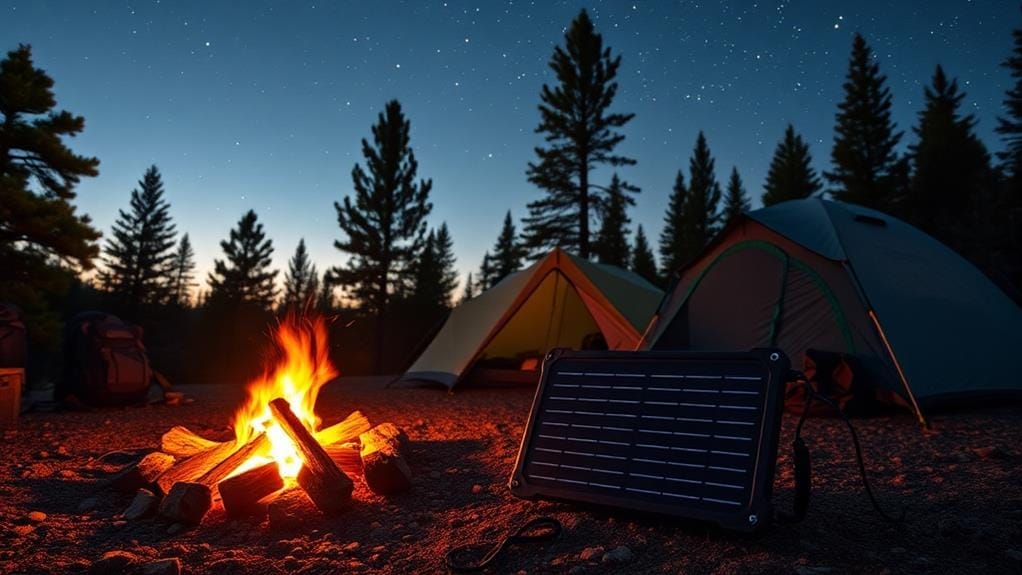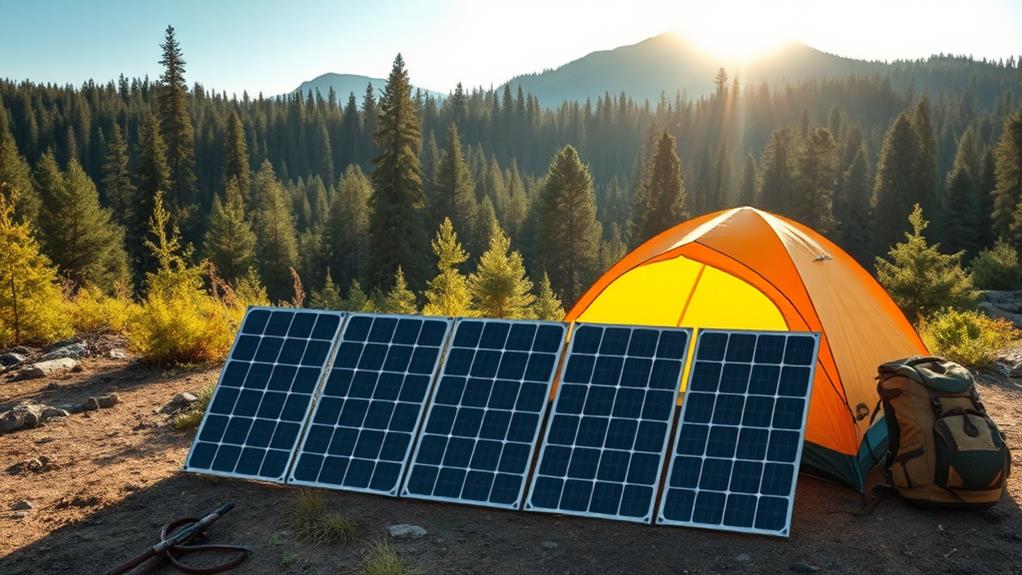For your off-grid adventures in 2025, consider these top-performing portable solar panels: EF ECOFLOW 110W, DOKIO 160W, a 100W foldable option, Renogy 200W, EF ECOFLOW 220W, and BigBlue 28W. These panels offer high efficiency (23-25%), durability (IP68 ratings), and versatile charging capabilities. You’ll find lightweight, compact designs ranging from 8 to 17 pounds, with real-world outputs of 65-90% of rated capacity. Key features include ETFE coatings for weather resistance, adjustable kickstands for maximum sun absorption, and compatibility with various devices and power stations. To make an informed decision, you’ll need to weigh factors such as power output, portability, and specific use-case requirements.
Key Takeaways
- High-efficiency panels with 23-25% conversion rates offer superior performance for off-grid adventures.
- Lightweight, foldable designs enhance portability, with top models weighing between 8-17 pounds.
- Weather-resistant features like IP68 ratings and ETFE coatings ensure durability in harsh outdoor conditions.
- Multiple output ports and compatibility with various devices increase versatility for different off-grid needs.
- Real-world output of 65-90% of rated capacity helps set realistic expectations for off-grid power generation.







EF ECOFLOW 110W Portable Solar Panel for Camping and RVs
- Highly Efficient. With an industry-leading 23% conversion rate, EcoFlow solar panels can charge your solar generator faster and more efficiently than...
- Powerfully Portable. Foldable solar panels that are designed to go wherever life takes you. Ideal as an RV solar panel, camping solar panel and...
- Weather, Water and Dust Proof. With an IP68 waterproof rating, these portable solar panels are made for the outdoors and can withstand the elements.
Last update on 2025-12-23 / Affiliate links / Images from Amazon Product Advertising API
For outdoor enthusiasts seeking reliable off-grid power, the EF ECOFLOW 110W Portable Solar Panel offers a compelling solution. This high-efficiency panel boasts a 23% conversion rate and an IP68 waterproof and dustproof design, making it suitable for camping, RV use, and various outdoor activities. You’ll find that its foldable design and kickstand case enhance portability and allow for ideal solar exposure adjustment. While performance can vary, users report real-world output ranging from 65-90% of rated power, with some achieving up to 136W in perfect conditions. Despite its higher price point compared to competitors like Renogy and Dokio, the EF ECOFLOW panel’s compact size and aesthetic appeal may justify the cost for those prioritizing space efficiency. However, consider alternative brands if you’re seeking better value per watt or comparable performance in similar conditions.
Best For: Outdoor enthusiasts and RV users who prioritize portability, aesthetics, and high-efficiency solar charging in a compact design.
Pros:
- High conversion efficiency (23%) with IP68 waterproof and dustproof design
- Foldable and portable with adjustable kickstand for optimal solar exposure
- Reliable performance in various conditions, including extreme weather
Cons:
- Higher price point compared to competitors with similar or better output
- Mixed user reviews on real-world performance and long-term durability
- Potential for overheating and cracking during extended use
DOKIO 160W Portable Solar Panel Kit (Folding Solar Charger)
- 【COMPACT & TRAVEL-READY】 Folds down to 19.3x20.9x1.1in and just 7.3lb—light enough to pack, carry, and set up solo. Perfect for RVs, vans,...
- 【LONG CABLE, COOLER & SAFER】 9.8ft (3m) cable lets you park the panel in full sun while your controller or power station stays shaded—better...
- 【SEPARATE CONTROLLER, SAFER CHARGING】 Includes a standalone PWM controller for 12V batteries with full protections (reverse polarity, overcharge,...
Last update on 2025-12-23 / Affiliate links / Images from Amazon Product Advertising API
Adventure enthusiasts seeking a versatile and powerful solar solution will find the DOKIO 160W Portable Solar Panel Kit an excellent choice. This lightweight, foldable panel weighs only 9 lb (7.28 lb for the panel itself) and measures 20.9L x 19.3W x 1.1H inches when unfolded. Featuring high-efficiency monocrystalline solar cells, the kit delivers 160W of power at 18V, making it compatible with various 12V batteries and power stations. The package includes a 10A controller and multiple connector types (SAE/XT60/DC/Alligator clip), ensuring versatility for outdoor activities, RVs, boats, and emergency power needs. With built-in protection against overcharging, overload, and short-circuits, the DOKIO kit offers peace of mind during off-grid adventures. The 9.85 ft cable from panel to controller provides flexibility in setup, while an optional 19.7 ft extension cable is available for increased range.
Best For: Outdoor enthusiasts, campers, RV owners, and emergency preppers seeking a powerful, portable, and versatile solar charging solution for off-grid power needs.
Pros:
- Lightweight and foldable design for easy portability
- High power output of 160W with versatile connectivity options
- Compatible with various 12V batteries and popular power stations
Cons:
- Relatively high price point compared to lower wattage options
- Limited warranty period of only 1 year
- May require additional accessories for optimal use in some situations
100W Portable Foldable Solar Panel for Power Station and Camping
- 🔋𝐇𝐢𝐠𝐡 𝐂𝐨𝐧𝐯𝐞𝐫𝐬𝐢𝐨𝐧 𝐄𝐟𝐟𝐢𝐜𝐢𝐞𝐧𝐜𝐲 - Harness the power of the sun with our 100W...
- 🔄𝐖𝐢𝐝𝐞 𝐂𝐨𝐦𝐩𝐚𝐭𝐢𝐛𝐢𝐥𝐢𝐭𝐲 𝐟𝐨𝐫 𝐏𝐨𝐰𝐞𝐫 𝐍𝐞𝐞𝐝𝐬 - Engineered with...
- 🌧️𝐃𝐮𝐫𝐚𝐛𝐥𝐞 & 𝐖𝐞𝐚𝐭𝐡𝐞𝐫-𝐑𝐞𝐬𝐢𝐬𝐭𝐚𝐧𝐭 𝐃𝐞𝐬𝐢𝐠𝐧 - Built for the...
Last update on 2025-12-23 / Affiliate links / Images from Amazon Product Advertising API
Off-grid enthusiasts and outdoor adventurers will find the 100W Portable Foldable Solar Panel an essential companion for their power needs. This monocrystalline solar panel, boasting a maximum conversion efficiency of 23.7%, can fully charge a 500Wh power station in just 7 hours under ideal sunlight conditions. With its IP65 waterproof rating and multi-layered ETFE lamination, the panel withstands various weather conditions, ensuring durability and longevity. The device’s versatility is evident in its compatibility with numerous solar generators, facilitated by multiple connectors for brands like Jackery, Goal Zero, and Blutti.
You’ll appreciate the panel’s portability, weighing only 8.16 pounds and featuring a TPE rubber handle. The inclusion of two adjustable kickstands allows for perfect positioning to maximize solar exposure. With 1 USB-C (5V, 3A) and 1 USB-A (5V, 3A) port, you can directly charge two small devices simultaneously, adding to the panel’s utility during your off-grid adventures.
Best For: This portable solar panel is best for camping enthusiasts, off-grid adventurers, and eco-conscious individuals seeking a reliable and efficient power source for their outdoor activities or emergency preparedness.
Pros:
- High conversion efficiency (up to 23.7%) for faster charging of devices and power stations
- Versatile compatibility with multiple solar generators and small devices through various connectors
- Durable and weather-resistant design with IP65 waterproof rating and ETFE lamination
Cons:
- Relatively heavy at 8.16 pounds, which may be cumbersome for ultralight backpackers
- Actual power output may vary depending on weather conditions and sunlight availability
- Limited to charging smaller devices directly; larger appliances require a separate power station
Renogy 200W Portable Foldable Solar Panel
- [Industry-Leading Efficiency 25%] Upgraded with 16BB N-Type cell technology, Renogy solar panels for camping achieve 25% efficiency—outperforming...
- [Lightweight & Magnetic Handle Design] Weighing only 13.89 lbs, renogy portable solar panel is the lightest in its class. Innovative folding design...
- [Versatile Off-Grid Power] Charge 3 devices simultaneously with 1 USB-C PD (45W max) and 2 USB-A ports (18W & 15W), perfect for smartphones, tablets,...
Last update on 2025-12-24 / Affiliate links / Images from Amazon Product Advertising API
The Renogy 200W Portable Foldable Solar Panel is a powerhouse for outdoor enthusiasts who need reliable energy on the go. With a power output of 200 watts and an impressive 23.5% conversion efficiency, this panel utilizes Grade A solar cells and ETFE material to maximize performance. Its compact design, measuring 25L x 21.1H x 2.2W inches when folded, and weighing just 17.6 pounds, makes it ideal for RV trips, camping, and off-grid activities. The panel’s IP65 rating guarantees protection against water splashes and dust, while the IP68 solar connectors provide durability in outdoor conditions.
You’ll appreciate the versatility of this panel, featuring multiple output ports including an industry-standard solar connector, a Type C port, and two USB-A outputs for simultaneous device charging. The four mounting holes facilitate easy attachment to vehicles or trees, enhancing its adaptability in various outdoor scenarios. With a customer rating of 4.5 out of 5 stars, this Renogy panel ranks #29 in Solar Panels on Amazon, offering a reliable solution for your portable power needs.
Best For: This solar panel is best for outdoor enthusiasts, RV owners, and off-grid adventurers who need a reliable, portable power source for their devices and equipment during camping trips, fishing expeditions, or extended stays in remote locations.
Pros:
- High efficiency with 23.5% power conversion rate
- Versatile output options including USB-A, Type-C, and standard solar connector
- Lightweight and foldable design for easy transportation and storage
Cons:
- May be too heavy for backpacking or ultralight camping at 17.6 pounds
- Not suitable for prolonged water immersion despite IP65 rating
- Relatively new product, available only since November 2023, so long-term durability is untested
EF ECOFLOW 220W Portable Solar Panel with Adjustable Kickstand
- [High-Efficiency Solar Panel] With the portable solar panel industry's first use of N-Type solar technology, we've raised the bar on conversion...
- [Adjustable and Versatile] The 220 watt solar panel is designed with a 30-60° adjustable angle bracket and an integrated solar angle guide,...
- [Durable and Robust] The ETFE coating ensures the 220W solar panel is built to last, offering extended longevity and resistance against harsh weather...
Last update on 2025-12-24 / Affiliate links / Images from Amazon Product Advertising API
For outdoor enthusiasts seeking powerful, efficient solar charging, the EF ECOFLOW 220W Portable Solar Panel stands out. This NextGen foldable solar panel boasts an impressive 25% conversion efficiency, utilizing TOPCon solar technology to maximize power generation. With its adjustable angle bracket, allowing for 30-60° tilt, you can optimize sunlight absorption throughout the day. The panel’s durability is guaranteed by its ETFE coating and IP68 rating, providing resistance against harsh weather conditions, water, and dust.
Weighing only 15.9 lb, this compact and foldable panel is ideal for camping, RV use, and off-grid systems. The EF ECOFLOW 220W operates at 21.5 volts and 60 Hz, delivering reliable performance in various outdoor scenarios. The package includes a solar to XT60i charging cable, protective bag, and necessary documentation, guaranteeing you have everything needed for immediate deployment and use.
Best For: Outdoor enthusiasts, campers, RV owners, and off-grid living enthusiasts seeking a high-efficiency, portable solar charging solution.
Pros:
- High conversion efficiency of 25% using advanced TOPCon solar technology
- Adjustable angle bracket (30-60°) for optimal sunlight absorption
- Durable and weather-resistant with ETFE coating and IP68 rating
Cons:
- Relatively high price point compared to lower wattage portable solar panels
- May be bulky for backpackers or those with limited storage space
- Limited customer reviews available, making long-term reliability assessment challenging
BigBlue 28W Portable Solar Charger with 3 USB Ports
- Advanced Performance: BigBlue 28W portable solar charger provides 20% more power from every ray, thanks to shadow-free surface design (No metal lines...
- Upgraded Triple-Port: Dual USB-C and one USB-A ports deliver a maximum output of 5V/3A each, collectively achieving 5V/4.8A. This solar panel charger...
- High-Efficiency & IP44 Waterproof: 28W USB solar panel phone charger converts 25.4% sunlight into free energy – industry-leading efficiency. Our...
Last update on 2025-12-24 / Affiliate links / Images from Amazon Product Advertising API
Adventure seekers and outdoor enthusiasts looking for a reliable power source during their off-grid escapades will find the BigBlue 28W Portable Solar Charger an excellent companion. This lightweight, compact device boasts triple USB-A ports with a maximum output of 5V/2.4A per port and a total current of 5V/4.8A, utilizing smart charge technology to optimize charging speeds for various devices. With a solar conversion efficiency of up to 25.4%, the charger effectively powers smartphones, tablets, and small electronics. Its IPX4 waterproof rating guarantees durability in diverse weather conditions, making it ideal for camping trips, outdoor festivals, and emergency kits. While the BigBlue excels in direct sunlight, charging efficiency may decrease in shaded or cloudy conditions. Users should note that it’s not suitable for larger devices like laptops or iPad Pros, and Apple products require additional original cables for compatibility.
Best For: Outdoor enthusiasts, campers, hikers, and festival-goers seeking a portable and reliable solar charging solution for small electronic devices during off-grid adventures.
Pros:
- High solar conversion efficiency (up to 25.4%) for effective charging
- Lightweight, compact, and durable design with IPX4 waterproof rating
- Multiple USB ports with smart charge technology for optimized charging speeds
Cons:
- Less effective charging in shaded or cloudy conditions
- Not suitable for charging larger devices like laptops or iPad Pros
- Requires additional original cables for compatibility with Apple products
Factors to Consider When Choosing Portable Solar Panels

When selecting portable solar panels for your off-grid adventures, you’ll need to weigh several critical factors to guarantee peak performance and functionality. Your decision should be informed by considerations such as the panel’s power output and efficiency, its portability and weight, durability and weather resistance, compatibility with your devices, and charging speed performance. By carefully evaluating these aspects, you’ll be able to choose a solar panel that meets your specific needs and enhances your outdoor experiences.
Power Output and Efficiency
Choosing the right portable solar panel for your off-grid adventures hinges on understanding power output and efficiency. Power output, measured in watts, directly correlates to a panel’s energy production capacity. Higher wattage panels, such as 200W or 220W models, offer greater charging potential for your devices and systems. However, it’s essential to evaluate that real-world performance often falls between 65-90% of the rated power due to variables like sunlight intensity and exposure angle.
Efficiency rates, expressed as percentages, indicate a panel’s ability to convert sunlight into usable energy. High-efficiency panels can achieve rates of 23-25%, with monocrystalline cells generally outperforming polycrystalline alternatives. When selecting a panel, you’ll need to balance your specific power requirements against the conditions in which you’ll be using the equipment. Factor in the type of solar cell technology, as this impacts overall efficiency. Remember, while higher wattage and efficiency ratings are generally desirable, they often come with increased cost and weight. Analyze your power needs carefully to determine the best balance of output and efficiency for your off-grid setup.
Portability and Weight
Portability and weight stand out as essential factors when selecting portable solar panels for off-grid adventures. When you’re considering your options, you’ll find that panel weights can vary considerably, ranging from ultralight models at 7.28 lbs to heftier units exceeding 17 lbs. This weight differential can greatly impact your mobility and overall user experience, especially during activities like camping or hiking where every ounce matters.
To enhance portability, look for panels with foldable designs, which allow for compact storage and easy transportation. Panel thickness is another important aspect, with some models measuring as slim as 1.1 inches, facilitating more efficient packing. The materials used in construction play a key role in determining weight; panels utilizing lightweight polyester, for instance, offer superior portability compared to those made with heavier materials. Additionally, a well-designed kickstand can greatly improve usability by enabling angle adjustments for maximum sun exposure without the need for additional support. This feature not only enhances portability but also contributes to the panel’s overall efficiency in various environmental conditions.
Durability and Weather Resistance
For adventurers seeking reliable off-grid power, durability and weather resistance are crucial factors in selecting portable solar panels. When evaluating options, prioritize panels with an IP68 rating, which guarantees complete protection against dust ingress and water immersion. This rating guarantees peak performance in harsh outdoor conditions, safeguarding your power source during inclement weather.
Consider panels constructed with ETFE (Ethylene Tetrafluoroethylene), a material renowned for its longevity and resistance to UV exposure and extreme temperatures. High-quality panels should feature waterproof and dustproof designs, important for maintaining reliability during outdoor activities. Assess the panel’s thickness and foldability, aiming for models around 1-1.5 inches thick, which strike a balance between portability and structural integrity. Lightweight, compact designs facilitate easy transportation without compromising durability. Additionally, examine warranties and customer feedback regarding long-term resilience to verify the panel can withstand regular outdoor use. By carefully considering these factors, you’ll select a portable solar panel capable of withstanding environmental challenges, providing consistent power generation for your off-grid adventures, and maintaining performance integrity over extended periods of use in diverse weather conditions.
Compatibility With Devices
As you commence selecting portable solar panels for your off-grid adventures, device compatibility should be at the forefront of your considerations. Verify that the panels you choose feature output ports that align with your devices’ charging requirements, such as USB-A, USB-C, or DC connectors. Some solar panels offer multiple connector options, including 8mm, XT60, and alligator clips, enhancing their versatility for various battery types and power stations.
When evaluating compatibility, focus on the panel’s wattage output to meet your power needs. For instance, a 160W panel can effectively charge 12V batteries and support diverse power stations. Additionally, check the voltage ratings; most portable options operate at 18-21.5 volts, which is standard for charging 12V systems. It’s essential to confirm that the solar panel can deliver the necessary amperage for your devices. A 160W panel typically provides around 8.89 amps, suitable for most small electronics and batteries. By carefully considering these factors, you’ll confirm that your chosen solar panel seamlessly integrates with your off-grid power ecosystem, maximizing efficiency and functionality during your adventures.
Charging Speed Performance
Beyond compatibility, charging speed performance is a key factor when selecting portable solar panels for off-grid adventures. Conversion efficiency plays an essential role, with top-tier panels achieving up to 25% efficiency, enabling faster energy conversion from sunlight to usable power. You’ll find that real-world performance often delivers 65-90% of the rated output under ideal conditions, which directly impacts your device charging times. Environmental factors, such as shade, cloud cover, and solar angle, greatly affect charging speeds; panels are engineered to perform effectively in direct sunlight.
When evaluating options, consider that some models have demonstrated superior charging capabilities for solar generators, with users reporting outputs of up to 136W in perfect scenarios. The panel’s capacity also influences charging speed; a 220W panel typically outperforms a 100W panel, assuming consistent conditions. To maximize charging efficiency, you’ll need to account for these variables and select a panel that aligns with your specific power requirements. Remember, while manufacturer specifications provide a baseline, real-world performance can vary. Carefully assess your power needs and anticipated usage conditions to choose a portable solar panel that delivers the charging speed necessary for your off-grid adventures.
Cost and Value Analysis
Weighing the cost against value is essential when selecting portable solar panels for your off-grid adventures. When comparing options, analyze the cost per watt to identify panels offering higher wattage outputs at lower prices, potentially providing more cost-effective solutions. While high-efficiency panels, boasting conversion rates above 23%, may come with a premium price tag, they often justify the investment through faster charging and superior performance in low-light conditions. Consider the warranty and customer support as vital factors in your value assessment, as longer warranties and responsive assistance can mitigate risks associated with higher upfront costs.
Durability features, such as IP65 waterproof ratings and rugged materials, greatly influence a panel’s long-term value, especially for outdoor use. These attributes impact sustained performance and potential replacement costs. Evaluate user feedback on real-world performance consistency, as panels demonstrating reliable charging in varied conditions may warrant a higher price point. When conducting your cost-benefit analysis, factor in the panel’s efficiency, durability, warranty, and user-reported performance to determine the most suitable option for your off-grid power needs.
Frequently Asked Questions
How Long Do Portable Solar Panels Typically Last Before Needing Replacement?
Have you ever wondered about the longevity of your portable solar investment? You’ll be pleased to know that high-quality portable solar panels typically last 20-25 years before needing replacement. However, their efficiency may decrease by 0.5-1% annually. Factors affecting lifespan include panel type (monocrystalline, polycrystalline, or thin-film), environmental conditions, and maintenance. Regular cleaning and proper storage can extend their life. It’s crucial to recognize that charge controllers and batteries may need replacement sooner, usually every 5-10 years.
Can Portable Solar Panels Be Used to Charge Electric Vehicles?
You can use portable solar panels to charge electric vehicles (EVs), but there are limitations. Most portable panels don’t generate enough power for a full EV charge. They’re more suitable for trickle charging or maintaining battery levels. You’ll need multiple high-wattage panels, typically 100W or more, connected in parallel. The charging process is slow, often taking days for a significant charge. For practical EV charging, you’re better off using dedicated, high-capacity solar installations or traditional charging stations.
Are There Any Safety Concerns When Using Portable Solar Panels in Wet Conditions?
When using portable solar panels in wet conditions, you’ll need to take into account several safety concerns. First, make sure your panels are IP65-rated or higher for water resistance. You should avoid submerging the panels or exposing them to heavy rain. Always keep connections dry and use weatherproof cables. Be cautious of electrical shock risks, especially with higher voltage systems. Inspect your equipment regularly for damage or corrosion. Additionally, think about using a charge controller with built-in safety features to protect against short circuits and overcharging.
How Do Portable Solar Panels Perform in Low-Light or Cloudy Environments?
Like a flower struggling to bloom on a gloomy day, portable solar panels face challenges in low-light conditions. You’ll notice reduced efficiency, with output dropping to 10-25% of rated capacity on overcast days. Monocrystalline panels typically outperform polycrystalline in these scenarios. To mitigate, you can use larger panels, employ MPPT charge controllers, or consider adding a battery bank. Some manufacturers offer specialized low-light panels with optimized cell arrangements and anti-reflective coatings to enhance performance in suboptimal conditions.
Can Portable Solar Panels Be Connected in Series for Increased Power Output?
You can indeed connect portable solar panels in series to increase power output. When you wire panels in series, you’ll add their voltages together while maintaining the same current. This configuration is useful for charging higher-voltage battery banks or powering devices with higher voltage requirements. However, you’ll need to guarantee your charge controller can handle the increased voltage. It’s essential to match panel specifications and use appropriate connectors to maximize efficiency and prevent damage to your system.















